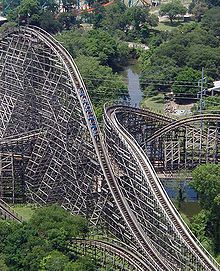Kinetic energy
| Kinetic energy | |
|---|---|

The cars of a roller coaster reach their maximum kinetic energy when at the bottom of their path. When they start rising, the kinetic energy begins to be converted to gravitational potential energy. The sum of kinetic and potential energy in the system remains constant, ignoring losses to friction.
|
|
|
Common symbols
|
KE, Ek, or T |
| SI unit | joule (J) |
|
Derivations from
other quantities |
Ek = Et+Er |
In physics, the kinetic energy of an object is the energy that it possesses due to its motion. It is defined as the work needed to accelerate a body of a given mass from rest to its stated velocity. Having gained this energy during its acceleration, the body maintains this kinetic energy unless its speed changes. The same amount of work is done by the body in decelerating from its current speed to a state of rest.
In classical mechanics, the kinetic energy of a non-rotating object of mass m traveling at a speed v is . In relativistic mechanics, this is a good approximation only when v is much less than the speed of light.
The standard unit of kinetic energy is the joule.
The adjective kinetic has its roots in the Greek word κίνησις kinesis, meaning "motion". The dichotomy between kinetic energy and potential energy can be traced back to Aristotle's concepts of actuality and potentiality.
...
Wikipedia

